Bringing Technology to Life [Part Two]
Continuing the recap of our 2022 activities, this week we’re going to focus on our research methodology. The three SST principles of collaboration, respect and recognition, and sharing findings described in Part One of this blog have both informed and been informed by our working research methods. These are both quantitative and global in the form of the Sonic Map, and qualitative and local in the form of our case studies. From the start these two approaches were designed to give both a breadth and a depth to our research.
The Sonic Map
The SST project is designed to deploy non-extractive research methodologies in every aspect of our work. One key element of this is presenting our research findings in accessible and attractive ways in line with our third key principle of sharing research findings. The Sonic Map is one way we’re doing this capturing the global scope of the project. Individual sonic street technologies and their followers can find themselves on the map as part of a global scene, as well as a local or national one. Moreover, a particular type of SST, such as a Colombian picò, for example, can locate itself as part of an even larger global scene that includes sound systems, Mexican sonideros and Brazilian radiolas, for instance. In fact, all these SST are variations on very similar technological solutions for entertaining large crowds with recorded music. From the point of view of the project – though probably not the practitioners – this is what can be called a technological diaspora.
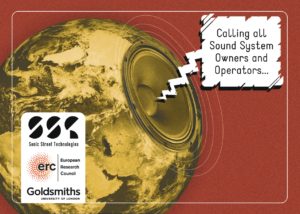
Sonic Map promo card: calling all sound systems
The Sonic Map is quite an ambitious output of the project, literally mapping out the SST scenes across the world. The information collected is crowd-sourced, in the sense that it is the voluntary contribution of the practitioners and operators, who have to register their sound system (or picò, or sonido, etc.) by filling out a questionnaire, which allows the map to be populated. As most of our research, the mapping is based on the trust and respect that we can cultivate within the scene – without that, it will just not happen. That’s why we work in close collaboration with existing associations and media platforms, as well as practitioners and aficionados of the culture who are well-known and, most importantly, trusted in one particular scene. There is no other way to do this kind of research other than in line with our first two principles: collaboration and recognition and respect.
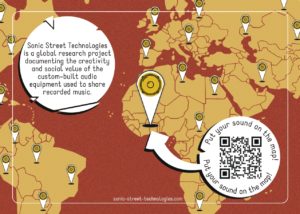
Promo card back: put yourself on the map
The online infrastructure for the map was about six months in the making, and the refining of the questionnaire took another six months, given the number of linguistic inflections and cultural nuances that it must be able to cover. Since its official launch in Autumn 2022, it has quickly gathered nearly 300 active sound systems. The interest from the practitioner’s communities is growing, also thanks to a dedicated social media campaign.
With the practitioner reasoning sessions and the Sonic Map we work with a considerable range of local researchers and practitioners. To do this efficiently we have tried to standardise our expectations and procedures. So, to this end we have a raft of protocols and notes for guidance in place.
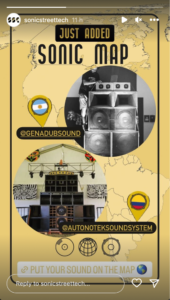
Astarbene social media campaign
Our Sonic Map is designed to become a unique resource of quantitative data to inform our research findings. These are to be published as surveys of a country or region’s SST activities. This information will also be used for providing a context for the qualitative analysis that individual case studies provide. It should also be added that we are well-aware of the critical theoretical and political issues – both historic and current – that need to be raised in respect of any mapping methodologies. This will be one of themes for discussion this year.
Case Studies
To compliment the global reach of the project we also have to delve into local particular details. This takes the form of case studies built around interviews and the gathering together of archive images and ephemera, such as gig flyers and so on. In keeping to our principle of sharing research findings, these interviews are filmed. Though not necessarily edited into a documentary (as we did do with Rockers Sound Station), interview extracts are to be made available as archive on our YouTube channel.
The interview transcripts form the basis of case studies written up for publication as book chapters by local researchers we’ve commissioned to do so. Case studies are an important work package and output for the project, offering the opportunity to get to the “nitty gritty” of a particular scene.
The case studies completed so far this year include two from the SST Jamaica team, Eight Decades of Jamaican Sound System Technology and Culture and The Dancehall Videolight ; one centred around the legendary Venn Street club in Huddersfield, UK, which turned a small Midlands town into an epicentre of British sound system culture in the 1980s; one very local to our base at Goldsmiths, Sound in’ Lewisham; and one on our social media partners, Astarbene.
-
- Astarbene case study
The Astarbene collective from Rome, Italy is a close associate of the SST project. They use their expertise on the sound system scene and event promotions to help the project on its social media presence. This past May, our Researcher Aadita Chaudhury had the opportunity to experience Astarbene’s activities in person, to better understand how the digital worlds of social media and the material worlds of live sonic street technologies performance and expertise intersect. This study further elaborated on some trends and questions that were first explored through a social media ethnography, started back in 2021, and laid the groundwork for future understanding of the relationship between social media and sonic street technologies ecosystems.
Most SST scenes are highly active on social media. This provides the project with a valuable source of material originated from within the scenes themselves. The social media ethnography was a vital way to both connect with SST communities globally and understand better how they have been in operation throughout the pandemic and its associated restrictions, which particularly challenged artistic and performance communities. SST studies the sound system scenes globally through Instagram to see how sound systems and their audiences interact and keep the scene alive, how they represent themselves, and position themselves as part of their local geographic communities and social movements. This digital ethnography was also a way to start thinking the relation between technology and culture that is at the heart of the project.
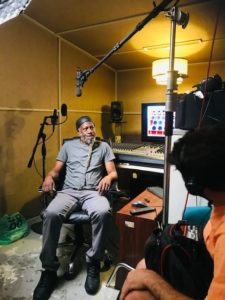
Jerry Lionz in filming with sound recordist with Joe Harris, June 2022
-
- Sound in’ Lewisham case study
Our Lewisham sound system case study, undertaken by Dr Natalie Hyacinth in 2022, was an excellent way to engage with the local Lewisham community through filmed interviews, conversations and historical research. To give a flavour of the project, here are a few words from the introduction:
Lewisham can be uniquely characterised by being at the forefront of both new sound system movements and radical political moments in British history. It is perhaps no surprise that two alternative subcultures, dub and punk, had roots in the borough. Alternative Black public spheres, as Paul Gilroy calls them, were a crucial part of the formation of a new culture ‘inna Inglan’ that acted as a kind of sonic resistance to the downpression of the city. Lewisham sound system culture in the early years of evolution and development was centred around community and culture, as well as, crucially, protection and survival. Police brutality and racial injustice have been part of day-to-day existence for many Black people in Lewisham…
The case study documents decade by decade the rise, fall and rebirth of Lewisham’s sound system culture. There are many London boroughs that can claim an equally important role in the culture – Brixton and Brent come to mind – and other cities, such as Bristol or Birmingham too. Resources allow only indicative sampling rather than comprehensive coverage. We felt committed to Lewisham not least as this is the borough in which Goldsmiths is located.
Conference presentations
In addition to sharing findings with the practitioners, in 2022 we did not neglect the conventional researcher communities whose modus operandi has traditionally been the conference. SST team members presented at the 7th Global Reggae Conference in association with SSO, organised by the Institute of Caribbean Studies and the Reggae Studies Unit at the University of the West Indies, Mona, Jamaica, in February 2022. Theconference theme was Reggae Films, Reggae Icons, Reggae Music. It is always a particular pleasure to be discussing sound systems in the original home of the culture.
We also made presentations in Coventry at the ‘Technology Justice: The Theories and Practices of Freedom’ Conference, Centre for Postdigital Cultures, Coventry University, in June 2022. Our panel was titledTechnologies for Survivance and Liberation: Sound, Power and Community. Both these conference presentations provided us with opportunities to share our work in progress and to receive some valuable feedback. Working on the SST project is very intense and concentrating on our collaborations, so the chance to consolidate team members’ thoughts for the wider research community is greatly valued.
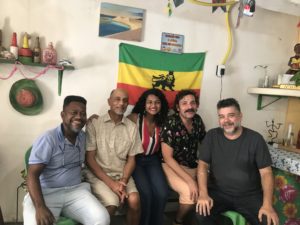
Some of SST Brazil: Fabio Abreu, Julian Henriques, Thalisse Ramos de Sousa, Marcus Ramusyo de Almeida Brasil, Leo Vidigal
-
- 4S Conference in Mexico
The highlight of our conference year was undoubtedly our participation at the Society for Social Studies of Science (4S) conference at Universidad Iberoamericana Puebla in Cholula, Mexico, in December. We organized two panels featuring work of SST scholars and practitioners at this annual meeting. The 4S conference is an important event for the global community of science and technology studies (STS) scholars. In 2022, the conference theme was Reunion, recuperation, reconfiguration: Knowledges and technosciences for living together – which was a very appropriate concept for the SST project’s ethos. As we engage deeply with STS literature, we were also very glad for Steve Jackson appreciation of the late Trevor Pinch in our session. [1] This was an important event for us as a project, at which to formally connect to the wider STS community and its social and scholarly worlds as our blog on 4S documents. We were happy to find the STS environment very conducive for our thinking and made some great contacts.
SST also commissioned three films to be premiered at the conference. This was in addition to – and as a departure from – the traditional academic presentations by project members and affiliates. These ten-minute documentaries were made by three sound systems with whom we have an ongoing relationship. The commission was for them to create films that represent the nature of their practice. Though we were happy to provide feedback and guidance, each film is very much the voices and images through which each sound system chose to represent themselves.
- The Brazilian collective based in Sao Paulo, Feminine Hi-Fi film made Street, Gender and Sound: the Feminine Hi-Fi Experience, demonstrated the way sound and music can be used to build a safe space for women in the scene to gather, entertain different generations, and nurture their own talents and skills.
- In Monkey Sound System’s film Spiritual Bass, Dakta Dub showed how sound system culture fits in with the ethos and philosophies related to sound that already exist in Indian culture, both traditionally and contemporarily.
- Bogota’s very own El Gran Latido sound system’s film, entitled Sonido Palabra Poder (Word Sound and Power), showed how sonic street technologies can play an active role into actual political struggles, as with El Gran Latido’s participation into the Paro Nacional ( National Strike) in Colombia in 2021.
The impact that these three short films made on the conference audience completely vindicated our film commissioning project. They made a big impression – in a very short space of time, especially with the filmmakers online from Brazil, India and Columbia for the Q&A session. This encourages us for more of this kind of work. Such film activity embodies our three key principles of collaboration, recognition and respect and sharing findings in a practical and efficient manner.
In yet another innovative contribution, following the academic and film panels, on the last day of the conference, SST arranged with the conference organisers to invite a local sound system, Sonido Axel, for a workshops and dance in an open space at the conference venue. Efren Moreno and his crew really appreciated the opportunity to play in a place – the Ibero campus – that they had never been before. This was also very much appreciated by the campus workers and security guards – seeing their culture on campus for the first time – if not by the university authorities who took exception to our poster (we might suspect because of its popular culture style). The event attracted a lot of attention from both conference goers and the university community at large.
As you might expect, we also took the opportunity of the conference location to initiate our Mexican sonidero research which we did to great success with local practitioners and local researchers (as named in Part One).
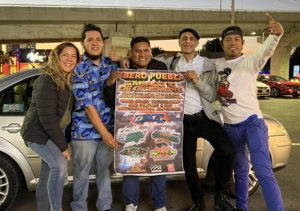
The controversial poster for Sonido Axel session on campus, with Yael, Sebastian, Efran, Julian and Roberto
Plans for 2023
Let’s conclude with a brief mention to what you can expect from SST in this coming year.
-
- Case Studies
Agreements, preparations and research is very much in progress for a number of case studies that will occupy much of our work – and that of our collaborators – this year. By the end of the project (in December 2025) we aim to have researched indicative examples of every type of SST from around the world. This year have our hands full with:
-
- India: sound systems and endogenous festival
- Canada: sound systems
- France: reggae sound systems and free party sound systems
- Brazil: funk. radiolas in Maranhão state and aparelhagem in Pará
- Mexico: Sonideros in CDMX and Puebla
- Colombia: Picós and sound systems
- Trinidad: the Carnival Truck
- South Africa: sound systems and festivals
-
- Premier Screening of UK Sound System Reasoning Day documentary
This will be staged at Goldsmiths supported by our sister organisation Sound System Outernational, as SSO#9. This is another important give-back to the sound system community involved on the day and beyond, a way to showcase not only the important reasonings that took place, but the connection between the generations that came from the day.
SSO#9 will also provide an opportunity to launch a pocket size brochure charting the history of sound system culture in Lewisham, decade by decade. This is an important output from the Lewisham case study as it is a way to share and give back, in an accessible form, the research upon which the community is centred.
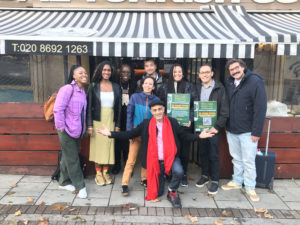
SST teams from Canada, France and Brazil at Goldsmiths for SSO#8: Alanna Stewart, Natalie Hyacinth, June Reid, Maria Emilia Escamilla, Brian D’Aquino, Safia Said, Jean-Christophe Seven, Marcus Ramusyo Brasil and Julian Henriques, November 2022
-
- YouTube archive
The SST YouTube channel is an excellent platform for making our work and findings available to the widest audience. During 2023 we plan to make extracts of our filmed interviews available and easily searchable and have appointed a video archivist, Siufran Adey, for this important job. The knowledge embodied in the skills, techniques and life experience of practitioners is the kind of understanding at the heart of the research project. As this is invariably expressed orally in conversation – rather than being written down – the sound or video recording is often the only archive that a popular culture can muster. With the older generation inevitably passing away, the video archive becomes even more important for their knowledge and experience to be passed on.
-
- Our website
We are planning for our website to provide more material for researchers (and anyone else) by making available detailed bibliographies (books, articles, MA and PhD theses, filmographies) of the research already published on a particular scene or country. This is a valuable output from the research process required at the start of every case study or country survey. There is also likely to be material gathered in the research process that exceeds what can be included in our publications that will also be made available on our website.
As a last word, we can say that we are planning discussions with collaborators and others to develop the theoretical frameworks to interpret the increasing volume of our findings. This is possible on the basis of our first year’s work setting up our online infrastructures (as with the website and the blog) and last year’s organising our work-flow with local collaborators and networks. Now, we are in a position to use our findings as material for asking the fundamental questions that the project raises, namely: the relationship between technology and culture, that is, bringing technology to life.
References
[1] Trevor Pinch was a founding figure for STS with books such as Pinch, Trevor and Trocco, Frank (2002) Analogue Days: The Invention and Impact of the Moog Synthesiser, Cambridge: Harvard University Press.
